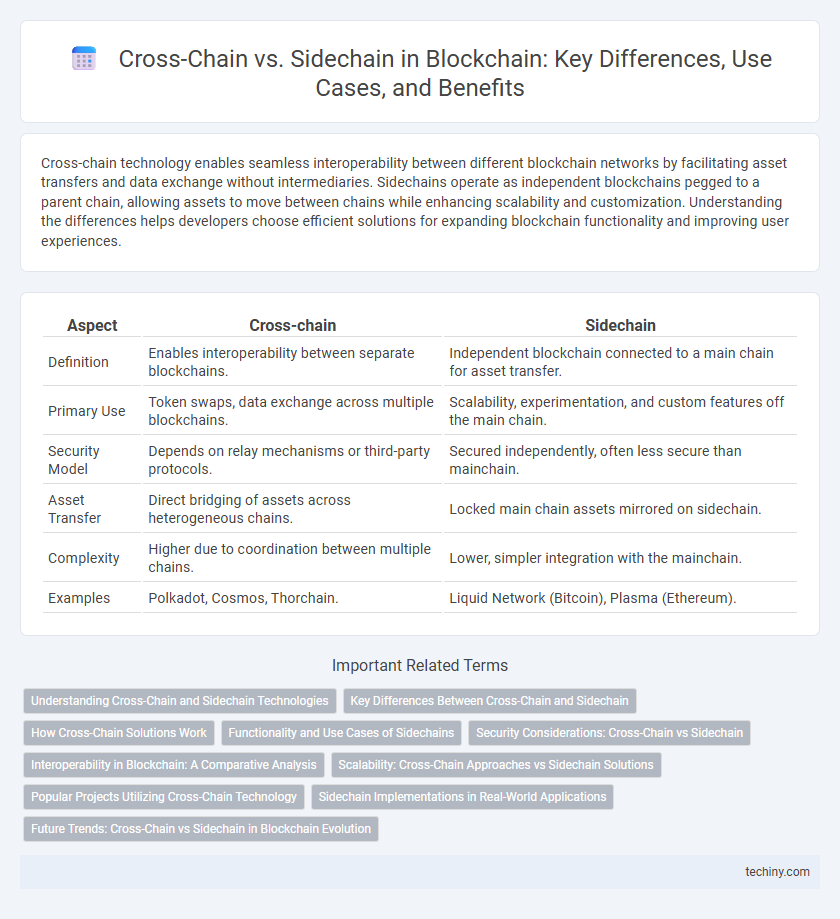Cross-chain technology enables seamless interoperability between different blockchain networks by facilitating asset transfers and data exchange without intermediaries. Sidechains operate as independent blockchains pegged to a parent chain, allowing assets to move between chains while enhancing scalability and customization. Understanding the differences helps developers choose efficient solutions for expanding blockchain functionality and improving user experiences.
Table of Comparison
| Aspect | Cross-chain | Sidechain |
|---|---|---|
| Definition | Enables interoperability between separate blockchains. | Independent blockchain connected to a main chain for asset transfer. |
| Primary Use | Token swaps, data exchange across multiple blockchains. | Scalability, experimentation, and custom features off the main chain. |
| Security Model | Depends on relay mechanisms or third-party protocols. | Secured independently, often less secure than mainchain. |
| Asset Transfer | Direct bridging of assets across heterogeneous chains. | Locked main chain assets mirrored on sidechain. |
| Complexity | Higher due to coordination between multiple chains. | Lower, simpler integration with the mainchain. |
| Examples | Polkadot, Cosmos, Thorchain. | Liquid Network (Bitcoin), Plasma (Ethereum). |
Understanding Cross-Chain and Sidechain Technologies
Cross-chain technology enables interoperability by allowing different blockchain networks to communicate and exchange assets directly, enhancing liquidity and functionality across multiple platforms. Sidechains operate as independent blockchains attached to a parent chain, enabling offloading of transactions and customized protocol features while maintaining a two-way peg for asset transfer. Understanding these technologies is essential for leveraging their distinct mechanisms to improve scalability, security, and cross-platform asset management in blockchain ecosystems.
Key Differences Between Cross-Chain and Sidechain
Cross-chain technology enables interoperability by allowing different blockchain networks to communicate and exchange assets directly, enhancing decentralized finance and multi-chain ecosystems. Sidechains operate as independent blockchains pegged to a main chain, providing scalability and customized functionality without affecting the main chain's security. Key differences include cross-chain's emphasis on connectivity between distinct chains versus sidechain's focus on offloading transactions to parallel chains with their own consensus mechanisms.
How Cross-Chain Solutions Work
Cross-chain solutions operate by enabling interoperability between distinct blockchain networks through protocols like atomic swaps or relay chains, ensuring secure and trustless asset transfers across chains. These mechanisms typically use cryptographic proofs and smart contracts to validate transactions without centralized intermediaries. As a result, cross-chain technology increases blockchain scalability and connectivity, allowing decentralized applications to leverage assets and data from multiple chains seamlessly.
Functionality and Use Cases of Sidechains
Sidechains enable the transfer of assets between different blockchains while maintaining independent consensus mechanisms, enhancing scalability and customization for specific applications. Their functionality supports use cases such as decentralized exchanges, gaming platforms, and privacy-focused transactions by allowing tailored protocols without congesting the main chain. This separation of operations optimizes performance and security for specialized blockchain environments.
Security Considerations: Cross-Chain vs Sidechain
Cross-chain solutions enable interoperability between multiple independent blockchains but often face heightened security risks due to reliance on external validators or bridges that can be vulnerable to attacks. Sidechains operate as separate blockchains attached to a main chain, providing enhanced security through isolation but require trust in the two-way peg mechanism for asset transfer. Evaluating the security trade-offs between cross-chain and sidechain frameworks is critical for applications handling significant asset values or sensitive data.
Interoperability in Blockchain: A Comparative Analysis
Cross-chain technology enables seamless asset transfers and data exchange across multiple independent blockchains, enhancing interoperability by allowing diverse ecosystems to communicate without intermediaries. Sidechains operate as separate blockchains connected to a parent chain, facilitating scalability and customized functionalities while maintaining a tether to the main network through two-way peg mechanisms. Cross-chain solutions prioritize broad compatibility and decentralization, whereas sidechains offer specialized control with potential trade-offs in security and decentralization.
Scalability: Cross-Chain Approaches vs Sidechain Solutions
Cross-chain approaches enhance scalability by enabling interoperability between multiple independent blockchains, allowing asset transfers and data sharing without congesting a single network. Sidechain solutions improve scalability through offloading transactions from the main chain to a parallel chain with its own consensus mechanism, reducing load and increasing throughput. Both methods address blockchain scalability but differ in architecture, with cross-chain emphasizing connectivity and sidechains focusing on transaction processing capacity.
Popular Projects Utilizing Cross-Chain Technology
Popular projects utilizing cross-chain technology include Polkadot, Cosmos, and Avalanche, which enable interoperability between multiple independent blockchains. Polkadot's relay chain architecture facilitates seamless communication and asset transfers across parachains, enhancing scalability and versatility. Cosmos uses the Inter-Blockchain Communication (IBC) protocol to connect heterogeneous blockchains, promoting decentralized applications across diverse ecosystems.
Sidechain Implementations in Real-World Applications
Sidechain implementations enable blockchain interoperability by allowing assets and data to move securely between the main chain and the sidechain while maintaining trust and decentralization. Prominent examples include Liquid Network for Bitcoin, which enhances transaction speed and privacy, and Polygon for Ethereum, providing scalable and low-cost smart contract execution. These sidechains facilitate real-world applications such as decentralized finance (DeFi), gaming, and supply chain management by offloading transactions and reducing mainchain congestion.
Future Trends: Cross-Chain vs Sidechain in Blockchain Evolution
Future trends in blockchain evolution indicate a growing emphasis on cross-chain interoperability to enable seamless asset transfers and data sharing across diverse blockchain networks, enhancing scalability and user experience. Sidechains will continue to provide customizable environments for specific use cases, improving transaction speed and reducing mainchain congestion while maintaining security through pegged assets. The integration of both cross-chain protocols and sidechains is expected to drive decentralized finance (DeFi) innovation and broader blockchain adoption by addressing scalability and flexibility challenges.
Cross-chain vs Sidechain Infographic

 techiny.com
techiny.com